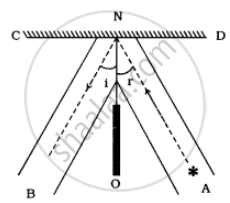Advertisements
Advertisements
Question
Verify experimentally the laws reflection of sound.
Solution
The laws of reflection are:
- The angle in which the sound is incident is equal to the angle in which sound is reflected.
- Direction of incident sound, direction of the reflected sound and the normal are in the same plane.
Reflection of sound

Take two metal tubes A and B. Keep one end of each tube on a metal plate as shown in figure. Place a wrist watch c at the open end of the tube A and interpose a cardboard between A and B. Now at a particular inclination of the tube B with the cardboard, ticking of the watch is clearly heard. The angle of reflection made by the tube B with the cardboard is equal to the angle of incidence made by the tube A with the cardboard.
For example, if the angle of incidence is 20° on the left side of a protractor (see figure arrangement), the angle of reflection at which we are able to hear the sound clearly will also be at 20° on the right side of the protractor.
∴ ∠ i = ∠ r ➝ verifying Law I
We will also further observe that pipe 1, pipe 2 i.e, the incident ray, reflected ray and the normal lie on the same plane, verifying law II.
APPEARS IN
RELATED QUESTIONS
Explain the following:
Mechanism through which a sound produces a nerve impulse in the inner ear.
Given in the box below are a set of 14 biological terms. Of these, 12 can be paired into 6 matching pairs. Out of the six pairs, one has been done for you as an example.
Example : endosmosis - Turgid cell.
Identify the remaining five matching pairs :
| Cushing’s syndrome, Turgid cell, Iris, Free of rod and cone cells, Colour of eyes, Hypoglycemia, Active transport, Acrosome, Addison’s disease, Blind spot, Hyperglycemia, Spermatozoa, Endosmosis, Clotting of blood. |
fill in the blanks with suitable functions: Ciliary body and __________.
State whether the following statements are true (T) or false (F). If false, correct them by changing any one single word in each.
Deafness is caused due to rupturing of the pinna.
Mention if the following statement is true (T) or false (F) Give reason.
The auditory nerve is purely for perceiving sound
Draw a labelled diagram of the inner ear.
Differentiate between:
Cochlea and Concha.
Draw a labeled diagram of the inner ear. Name the part of the inner ear that is responsible for static balance in human beings.
The range of audible frequency for the human ear is
The spiral organ possessing sensory cells for hearing is ______.
